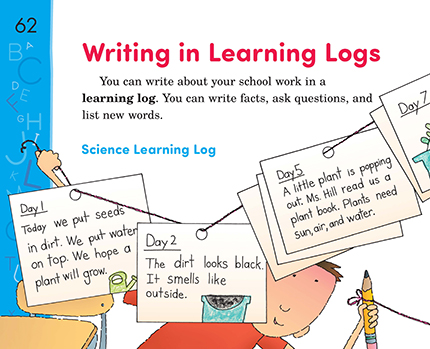Page 62 from

Start-Up Activity
Explain to students that a log is a written record of something. For example, ship captains keep logs, scientists keep logs, as do explorers and travelers. Inform students that keeping a learning log is a way for them to keep track of what is happening in their classes.
Read pages 62–63 to show students a learning log that records the process of a science experiment. Then plan a project in which students keep a log of their work or observations about a subject they are studying.
Enrichment Activity: Have students write learning log entries for a topic of their own choosing. (You can start with the ideas on page 63.) Or for a creative-writing project, have students write log entries as if they were another person (real or imagined) or an animal.
Think About It
“Writing helps you think and remember.”

Start-Up Activity
Explain to students that a log is a written record of something. For example, ship captains keep logs, scientists keep logs, as do explorers and travelers. Inform students that keeping a learning log is a way for them to keep track of what is happening in their classes.
Read pages 62–63 to show students a learning log that records the process of a science experiment. Then plan a project in which students keep a log of their work or observations about a subject they are studying.
Enrichment Activity: Have students write learning log entries for a topic of their own choosing. (You can start with the ideas on page 63.) Or for a creative-writing project, have students write log entries as if they were another person (real or imagined) or an animal.
Think About It
“Writing helps you think and remember.”